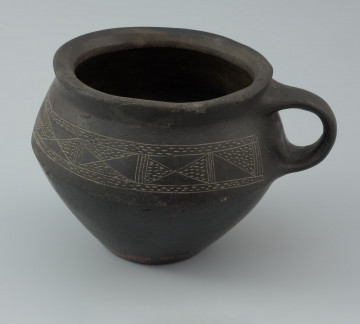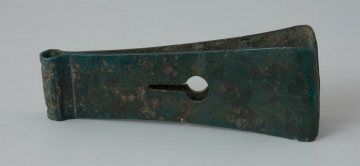
Decorated mug
National Museum in Szczecin
Part of the collection: Antiquity
Made of bronze, the belt hook consists of three parts. The earliest hooks were made of bars or rods with their ends bent inward. The more developed and later forms are the bi-partite and tri-partite hook. They consisted of two or three segments connected by a ring or a more elaborate segment. A completely different design is that of the so-called hinge-like hook, with flat arms connected by an axis like in a hinge. Belt hooks went out of use with the beginning of the new era, permanently replaced by more practical buckles. The hook from Podole Małe is decorated with ribs and a design stamped with a punch. This type of hooks is one of the rarest ones. From the Baltic region, only 20 specimens are known, most of them from lower Powiśle and the eastern part of Pomerania. The hook has been mentioned in archival sources since 1882. In 1889 it was listed by Hugo Schumann as a part of a collection of items from an unknown cemetery in Podole Małe, which also included scissors, umbo (a shield centre fitting), and a javelin arrowhead. It is not known, however, if these goods come from a single grave or several graves. The hook should be associated with the people of the Oksywie culture, living in Pomerania in the pre-Roman period, in the 2nd-1st centuries BC, on the area located to the east of the Ina River.
Bartłomiej Rogalski
Author / creator
Dimensions
cały obiekt: height: 2.6 cm, width: 24.7 cm
Object type
furnishings and equipment; belt; belt buckle
Technique
casting
Material
bronze
Creation / finding place
Owner
Muzeum Narodowe w Szczecinie
Identification number
Location / status

National Museum in Szczecin

National Museum in Szczecin

National Museum in Szczecin
DISCOVER this TOPIC
Castle Museum in Łańcut
DISCOVER this PATH
Educational path